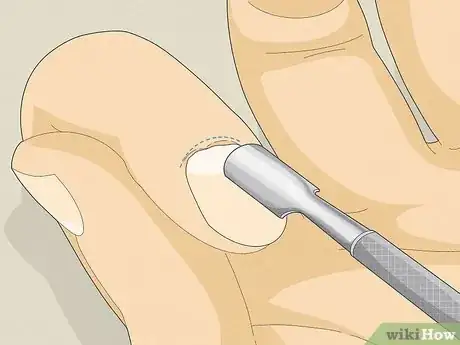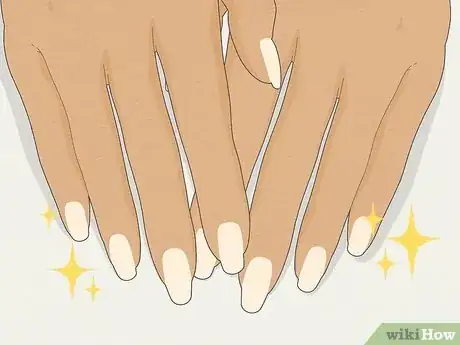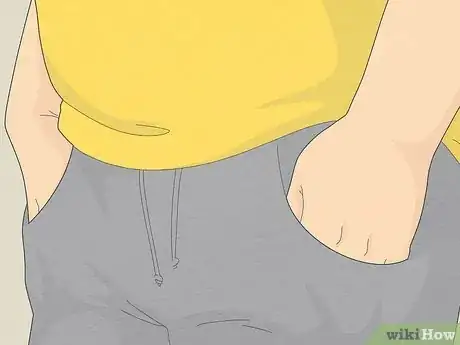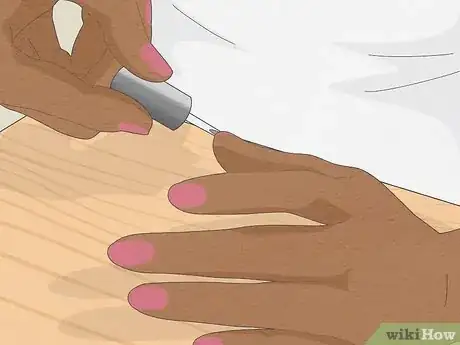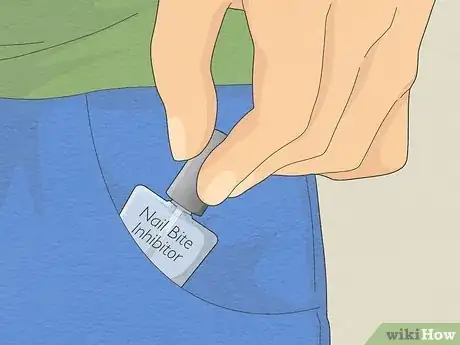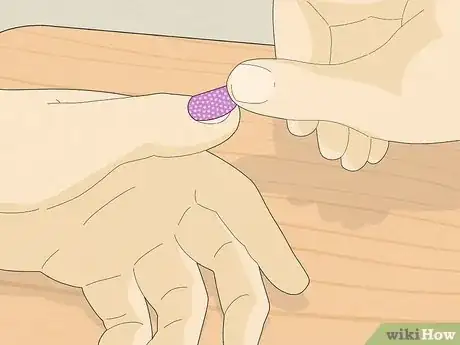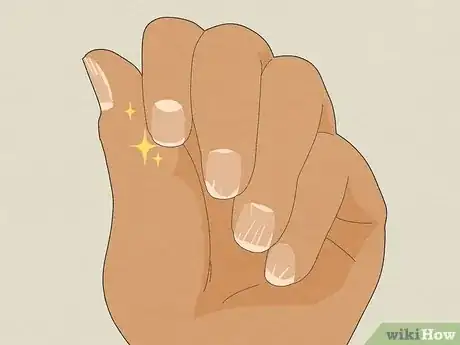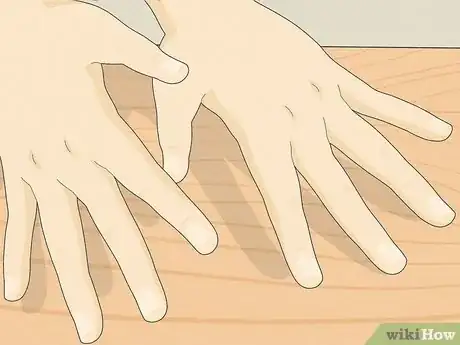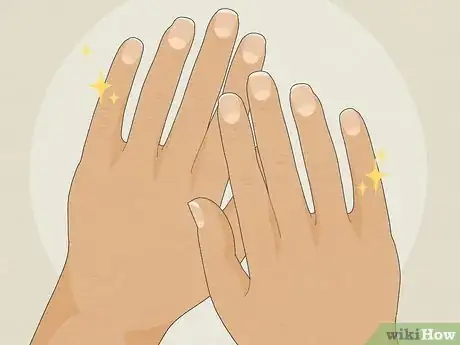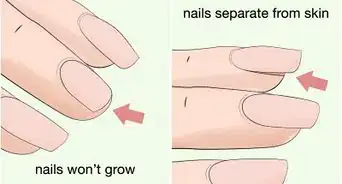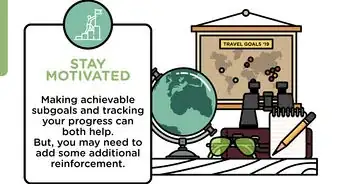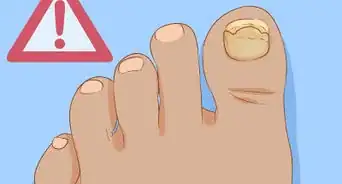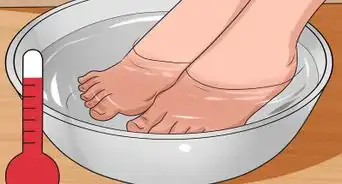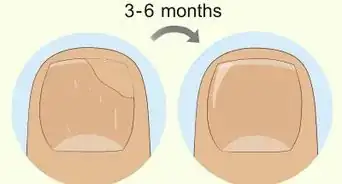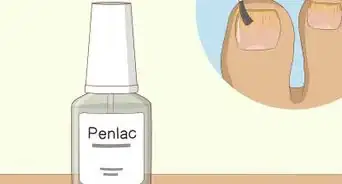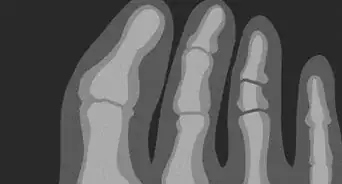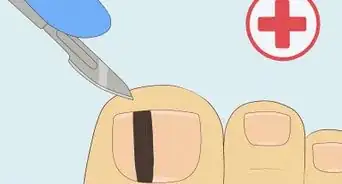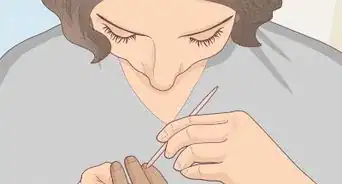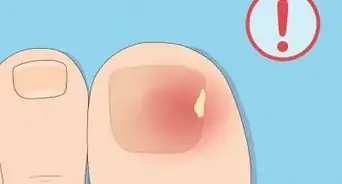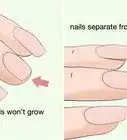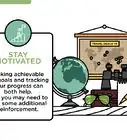This article was co-authored by Julia Yacoob, PhD. Dr. Julia Yacoob is a Licensed Clinical Psychologist practicing in New York City. She specializes in Cognitive Behavioral Therapy (CBT) for adults coping with a variety of symptoms and life stressors. Dr. Yacoob earned an MS and Ph.D. in Clinical Psychology from Rutgers University, and pursued specialized training at Weill Cornell Medical College, New York Presbyterian Hospital, Memorial Sloan-Kettering Cancer Center, the Institute for Behavior Therapy, and Bellevue Hospital Cancer Center. Dr. Yacoob is a member of the American Psychological Association, Women’s Mental Health Consortium, NYC Cognitive Behavioral Therapy Association, and Association for Cognitive and Behavioral Therapies.
wikiHow marks an article as reader-approved once it receives enough positive feedback. This article has 82 testimonials from our readers, earning it our reader-approved status.
This article has been viewed 4,097,854 times.
Nail biting is a bad habit that can make your hands look unsightly. It can also permanently damage your nails, teeth, or gums. Fortunately, there are some techniques you can try that will help keep you from biting your nails.
Steps
Maintaining Healthy Nails
-
1Treat yourself to a manicure as often as you can. A manicure may help you want to not bite your nails due to how nice they look, as well as the thought of having nail polish in your mouth. Not to mention, having nail polish on may push back the urge to bite your nails, sinceyou don't want to bite into nail polish or ruin your manicure.Once your nails are in great shape, you should focus on keeping them that way, and the best way to show off your shiny new nails is to get a manicure.[1]
Health Benefits of Manicures
Exfoliation. Your hands are exposed to more dirt and grime than any other part of your body, so they're constantly making new skin cells and shedding the old. Manicures usually include hand cleaning and moisturizing treatments to exfoliate your skin. This can keep your hands looking smooth and reduce the appearance of wrinkles over time!
Improved blood flow. Moisturizers and cuticle treatments are usually massaged into the skin, which helps to improve blood circulation. This can relieve pain and help your body distribute heat evenly.
Relaxation. Getting a manicure can be a great way to take a mental break in your day and feel pampered. You deserve it! -
2Keep your nails relatively short. A simple manicure can help maintain your healthy nails, and so will keeping them relatively short and preventing yourself from biting them more.[2]
- If you have any surplus growth, cut your nails back. Keep clippers with you at all times.You can't bite if there's nothing there.
Advertisement - If you have any surplus growth, cut your nails back.
-
3Push your cuticles back from time to time. Many nail-biters do not have "moons" on the base of their fingernails because their cuticles have not been pushed back. To do this, gently push your cuticles towards your finger to reveal more of your nail. This is easier to do after a shower when your hands and nails are wet.
- This makes the nail appear longer, and it will gives a more attractive shape, which might also be a motivation to stop biting.
-
4Maintain a healthy diet. A healthy diet will help you feel better overall and will help your nails repair and grow well.[3] Eat calcium and magnesium rich foods so that your nails will repair and grow well. Not only that, but most of the reason that the human body wants to bite nails is a lack of calcium and magnesium in the body. The body needs that material back.
Foods That Will Help Your Nails Grow
Protein-rich foods: lean meats (chicken, sirloin), nuts, spinach, chickpeas, soybeans, whole grains
Zinc-rich foods: oysters, legumes, red meats (in small amounts)
Calcium-rich foods: chia seeds, white beans, leafy greens, nuts
Magnesium-rich foods: pumpkin seeds, dark chocolate
Biotin-rich foods: bananas, peanuts, lentils, almonds (or almond butter)
Foods with essential fatty acids: tuna, salmon, shellfish, leafy vegetables -
5Celebrate your nail success. Don't be afraid to show off your new nails to your friends, or even to people you don't know very well. Show them your hands and say, "Can you believe I used to have a nail-biting problem?"
- Take photos of your hands and enjoy how good they look. You can even hang them up, or hang them next to a photo of your ragged "before" nails to show that you are capable of making big changes in your life.
Keeping Your Hands and Mouth Busy
-
1Find a habit to take the place of nail biting. Whenever you have the urge to bite, do that instead.[4] Some people like to drum their fingers, twiddle their thumbs, clasp their hands, put their hands in their pockets, or just stare at their hands. Just make sure it's not a bad habit; choose a helpful one or one that doesn't really matter either way.[5]
Habits to Replace Nail-Biting
Play with a small object. Carry a rubber band, penny, or something else to hold in your hands to play within place of biting your nails.
Distract your hands at key nail-biting times. Identify when you usually bite your nails, such as during car rides or when you're sitting in class, and find a new way to replace the habit depending on where you are. If you're in class, focus on writing extremely thorough notes. If you're in the passenger seat of a car, fiddle with your keys.
Mold silly putty or clay. Try keeping an "egg" of Silly Putty or a piece of clay with you. It is fun to play with and it occupies your hands during biting-prone times.
Keep a coin in your pocket. Try keeping a coin in your pocket, and play with it when you feel the urge to bite your nails. -
2Distract your hands by taking up a hobby. Not only will the new hobby keep you from biting your nails, but you could also discover a new passion at the same time.
Hobbies to Try
Cleaning your house. This hobby will pay off in having a cleaner house, which will likely help you feel happier when you spend time at home.
Knitting or crocheting. Learning to knit or crochet can result in beautiful scarves, hats, and sweaters that can make great gifts for your family.
Running. Exercise releases endorphins, which can help to calm your nerves. This would be helpful if you tend to bite your nails when you're nervous.
Nail art. Painting your nails and doing special nail art is a fun and creative way to curb your nail-biting habit!
Clay projects or plaster. This is a perfect art hobby for nail-biters because the plaster flavor stays in your fingers long after you wash it off. This will discourage you from biting. -
3Keep your mouth busy. Though you should avoid developing a serious new oral fixation, a few small tricks can keep your mouth busy and will cut down on the amount of time you spent biting your nails.
Ways to Keep Your Mouth Busy
Chew gum or suck on mints or candies throughout the day. Biting your nails will be tough if you're busy chewing gum or taking in the flavor of a delicious sucking candy. Also, the sensation of your bitten nails mixing with the flavor of minty gum or an orange-flavored candy will just be gross.
Snack small throughout the day. Though you should avoid snacking so much that you end up gaining weight, you should carry around healthy snacks like carrot sticks or celery so you can munch on them throughout the day.
Carry around a water bottle. Bring water with you wherever you go so you can always take a sip of water when you're having a weak moment. -
4Wear nail polish. Putting nail polish on your nails may help to discourage you from nibbling on them since a vibrant color can catch your attention and snap you out of your nail-biting habit. You'll also have more motivation to avoid biting your nails since you won't want to ruin the nice appearance.
- Chose a color you like so that you don't peel it off.
- Get a design. This will make you not want to peel off the polish if you like the design.
- Make polishing your nails a hobby. If you keep nail polish on long enough, your nails will have a chance to grow back!
Using a Nibble Inhibitor
-
1Paint a nibble inhibitor on your nails to discourage yourself from chewing them. Bitrex and Mavala Stop are two examples of popular inhibitors, but there are many options available. Check your local pharmacy, big box store, or grocery store. Some options may also be found online.
- Each of these inhibitors use a safe, non-toxic chemical that tastes foul.
-
Read the instructions prior to application.Generally, you'll need to paint the inhibitor on your nails as you would paint polish. When you absentmindedly go to bite the painted nail, you'll get a taste of the nasty inhibitor, making it easier to remember to avoid repeating the same behavior.
-
2Apply the solution to your nails several times a day. It might help to first apply a transparent coat of nail polish over the inhibitor as it lasts much longer and smooths the surface of your nails. The smooth surface will also help to remind you not to bite (it might turn out that applying only the coat will be sufficient).
-
3Carry some solution with you at all times. Place the bottle in your purse, car, or desk.When one coat wears off, apply another one.Persistence is important when using this method.
-
4Try using a different solution. As noted, there are numerous nibble inhibitors on the market. If one doesn't work for you or if you get too used to the taste, simply switch to another one and continue your efforts.
-
5Continue to apply the solution when you stop biting your nails. Even if you've stopped biting your nails, you can keep the solution around as a trophy.
- If you're ever tempted to bite your nails in the future, then you can smell the solution to remind yourself of how unpleasant the experience was.
- If you're ever tempted to bite your nails in the future, then you can
Covering Your Nails
-
1Cover your nails with nail polish.Try a bold color like red, or a color like black that will look silly if it's chipped because you're biting your nails.If you don't like color, polish them and apply some shine and growth promoter or petroleum jelly. It's harder to bite nails that are looking great.
-
2Wear fake nails. This is another great way to keep your nails covered. Get your nails professionally manicured, which involves getting acrylics glued to your nails. They last for ages and when you get them taken off, you will have your real natural nails underneath.
- If you're really determined, you can get a particularly expensive manicure with artificial nails. This will make you feel even worse about biting your nails and ruining your pricey look.
-
3Cover your nails by wearing gloves. Keep gloves in your back pocket and wear them when you want to bite. This will motivate you even more if it's the middle of summer and you look ridiculous wearing gloves.
- If you're writing or doing something else that is particularly tough to do with gloves, you will be even more motivated to stop biting your nails. Remind yourself that if you didn't have a nail-biting problem, that you wouldn't need to wear the gloves.
Breaking the Habit One Nail at a Time
-
1Pick one nail to "protect" at a time. If you have one nail that appears more damaged than the rest, it might be in your best interest to start with that nail. If all nails appear the same, however, you can pick any nail you wish.
- If you find it difficult to break the habit all at once, working on one nail at a time can make things easier by allowing you to slowly build better habits instead of demanding too much of yourself all at once.
- If you find it difficult to break the habit all at once, working on one nail at a time can make things easier by allowing you to
-
2Go a few days without biting that nail. You might be able to do so without help, but if you need some extra assistance, considerwrapping an adhesive bandage around the fingertip of your chosen nail.Doing so should block your access to the nail, making it harder to bite it.
-
3Notice how much better that nail looks than the others. After a few days, a non-bitten nail will flourish and reward you.
- Do not bite your chosen nail during this time. If you must, bite one of the 'unprotected' ones. Sometimes it even helps knowing that you have another nail to bite, even if you don't actually nibble at any unprotected ones.
-
4Pick another nail to stop biting. Once you have grown your non-bitten nail for a while, start protecting another one. During this time, however, it's important that youleave both the first and second nails alone.You wouldn't want to undo the good work you accomplished on the first nail by biting it after switching your focus to a new one!
-
5Repeat the process until you have successfully avoided biting all of your nails. If you ever really feel the urge to bite your nails, do the reverse of this process by focusing on just one nail to bite. That should help you limit the amount of damage done to the other nails.
Covering your Nails with Adhesive Bandages
-
1Put adhesive bandages over your nails. Cover your nail with the pad of the bandage, and wrap the adhesive part around the flesh of your fingertip.
-
2Keep the bandages on every single day until you stop biting your nails. You can apply fresh bandages every time you shower, every time the bandage gets soggy or dirty, or every few days.
- You can remove them for a special occasion, or choose to keep them on so you look silly during the occasion and are even more motivated to stop biting your nails.
- Unless you bite your nails in your sleep, it's probably a good idea to take the bandages off at night. Doing so will give your skin a chance to "breathe." You should also remove bandages that look notably moist or dirty.
-
3Take off the adhesive bandages after several weeks.It takes at least 21 days to break a habit,so you should be prepared to stick with this method for at least that long. You can remove the bandages after that point.
- To really break a habit, though, you should also work on replacing it with a positive habit. For instance, switch the chewing sugar-free gum or playing with a stress ball while consciously following the bandage procedure.[6] Replacing a bad habit with a neutral one usually makes it easier to break.
-
4Notice how much better your nails look. If you start biting your nails again, put the adhesive bandages back on for a longer period of time or attempt another method to quit.
- Some research suggests it may take up to three months to successfully break a habit, so don't expect yourself to be in the clear just yet.[7] Remain conscious about your habit and your desire to break it, even after you take the bandages off.
- Consider backing your efforts by painting your nails, getting a professional manicure, or using a bite inhibitor after removing the bandages.
Expert Q&A
-
QuestionIs it possible to quit nail biting?
 Julia Yacoob, PhDDr. Julia Yacoob is a Licensed Clinical Psychologist practicing in New York City. She specializes in Cognitive Behavioral Therapy (CBT) for adults coping with a variety of symptoms and life stressors. Dr. Yacoob earned an MS and Ph.D. in Clinical Psychology from Rutgers University, and pursued specialized training at Weill Cornell Medical College, New York Presbyterian Hospital, Memorial Sloan-Kettering Cancer Center, the Institute for Behavior Therapy, and Bellevue Hospital Cancer Center. Dr. Yacoob is a member of the American Psychological Association, Women’s Mental Health Consortium, NYC Cognitive Behavioral Therapy Association, and Association for Cognitive and Behavioral Therapies.
Julia Yacoob, PhDDr. Julia Yacoob is a Licensed Clinical Psychologist practicing in New York City. She specializes in Cognitive Behavioral Therapy (CBT) for adults coping with a variety of symptoms and life stressors. Dr. Yacoob earned an MS and Ph.D. in Clinical Psychology from Rutgers University, and pursued specialized training at Weill Cornell Medical College, New York Presbyterian Hospital, Memorial Sloan-Kettering Cancer Center, the Institute for Behavior Therapy, and Bellevue Hospital Cancer Center. Dr. Yacoob is a member of the American Psychological Association, Women’s Mental Health Consortium, NYC Cognitive Behavioral Therapy Association, and Association for Cognitive and Behavioral Therapies.
Clinical Psychologist Definitely! The key is understanding why you bite your nails to begin with—are you doing it because it feels good, or because it's a distraction? Chances are, you've been doing it as an adaptive coping skill, which is why it's a good idea to replace it with a new, healthier habit rather than cutting out the habit altogether.
Definitely! The key is understanding why you bite your nails to begin with—are you doing it because it feels good, or because it's a distraction? Chances are, you've been doing it as an adaptive coping skill, which is why it's a good idea to replace it with a new, healthier habit rather than cutting out the habit altogether.
Warnings
- Know when to get help. If your nail biting is such a problem that you're always biting your nails, frequently causing your cuticles to bleed, or even losing fingernails, you may not be able to stop biting your nails on your own. If this is the case, see a doctor as soon as you can to see if your problem is a symptom of a bigger issue like Obsessive Compulsive Disorder (OCD).⧼thumbs_response⧽
References
- ↑ https://www.aad.org/public/everyday-care/nail-care-secrets/basics/stop-biting-nails
- ↑ https://www.aad.org/public/everyday-care/nail-care-secrets/basics/stop-biting-nails
- ↑ https://www.onegreenplanet.org/natural-health/foods-that-make-your-nails-grow-fast-and-stay-stronger-longer/
- ↑ https://www.aad.org/public/everyday-care/nail-care-secrets/basics/stop-biting-nails
- ↑ http://www.psychologytoday.com/blog/making-habits-breaking-habits/201301/how-stop-biting-your-nails
- ↑ https://www.psychologytoday.com/us/blog/making-habits-breaking-habits/201301/how-stop-biting-your-nails
- ↑ http://www.today.com/health/think-itll-take-21-days-make-your-resolution-habit-try-2D11826051
- ↑ https://www.mayoclinic.org/healthy-lifestyle/adult-health/expert-answers/nail-biting/faq-20058548
About This Article
To stop biting your nails, clip them every few days to keep them short so there's nothing for you to bite. You can also wrap adhesive bandages around your nails while you're at home so you can't bite them. Alternatively, if you don't have bandages, try wearing a pair of gloves instead. Or, if you're comfortable painting your nails, get a manicure so you're less likely to bite them because of how nice they look! For more tips, like how to use chewing gum or using bad-tasting nail polish to stop biting your nails, scroll down!


